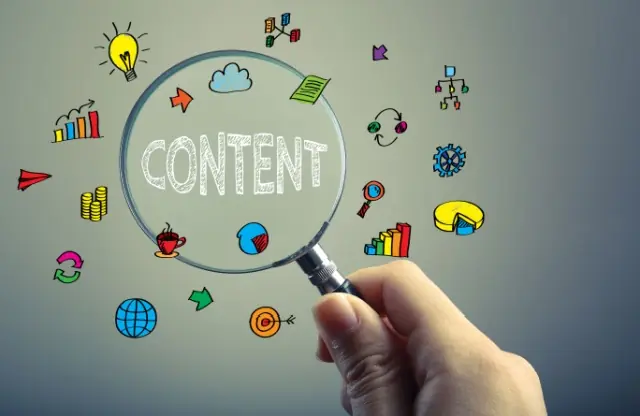
Welcome to the exciting world of content creation! As a content creator, your job is to make engaging, informative, and valuable content that connects with your audience. The content creation process includes several steps: ideation, planning, execution, and promotion. To create effective content, you need to understand content marketing. This helps drive engagement and growth. SEO (Search Engine Optimization) is also important. It ensures your content ranks high on search engines. With good content planning, you can make content that entertains, informs, and educates your readers.
In this article, we’ll explore what content creation is, who a content creator is, and why creating content is important for your brand. We’ll look at content ideation, content planning, and different types of content. These typically include blog posts, infographics, videos, podcasts as well as others. You’ll learn best practices for a content creation strategy, and the five-step content creation process. Finally, we’ll share tips on creating high-quality content and optimizing it for different platforms. Let’s get started!

What Is Content Creation?
Content creation is the process of generating various forms of media that appeal to your target audience. This involves multiple steps such as ideation, planning, creation, and promotion. As a content creator, you’re creating content that can range from blog posts and infographics to videos and podcasts. Each piece of content should align with your brand strategy and customer experience. This ensures that it provides value and engages your audience effectively.
The content creation process begins with content planning. This involves deciding what type of content you need and outlining the main ideas. Effective content creation requires a solid content strategy. This strategy should consider your audience’s needs. It should also consider the platforms you’ll use and how your content will support your brand-building efforts. SEO (Search Engine Optimization) is crucial. It helps your content rank higher on search engines and reach a broader audience.
Besides planning and strategy, understanding content marketing is essential. This involves promoting your content to attract and keep customers. Content marketing helps drive engagement and supports your brand-building goals. Each piece of content should have a specific purpose and audience in mind. This ensures it fits into your broader marketing efforts.
By following these steps and focusing on quality and relevance, you can create content that entertains, informs, and educates. This enhances your brand’s presence and effectiveness online.

Who is a Content Creator?
A content creator is someone who produces digital media that is engaging and informative for their audience. This can include various kinds of content like blog posts, videos, podcasts, social media updates, and more. The primary goal of a content creator is to capture the attention of their audience and provide value through their work.
Creating great content involves understanding the needs and interests of your audience. Content creators often work with content strategists and a design team to make their content appealing and effective. These professionals design visual elements and ensure the content matches the brand’s identity.
Content creators need to be skilled in content planning and execution. This means they must generate ideas, create the content, and then publish it across appropriate platforms. They also need to be knowledgeable about content marketing. This is crucial. Especially since it involves promoting their content to reach a wider audience and drive engagement. This promotional aspect is crucial for building a strong online presence and achieving brand goals.
Design is crucial in content creation for visual appeal and engagement. The design team creates graphics, layouts, and other elements to enhance content presentation. This collaboration helps ensure that each piece of content is not only informative but also attractive to viewers.
On the whole, content creation is a dynamic field that combines creativity with strategic planning. It requires continuous learning and adapting to new trends and technologies. This helps produce content that resonates with audiences and supports brand-building efforts.

Why Is Creating Content Important?
Content creation is essential for several reasons. It plays a vital role in attracting and retaining customers, enhancing your brand’s presence, and driving business growth. Here are key points explaining its importance:
1. Builds Trust and Credibility
Consistent and high-quality content helps establish your brand as an authority in your industry. Addressing your target audience’s pain points and providing valuable information, builds trust and credibility. This trust encourages customers to engage with your brand and choose your products or services over competitors.
2. Enhances SEO and Visibility
Content creation is crucial for improving your search engine rankings. By incorporating relevant keywords and optimizing your content for search engines, you increase the chances of your content being discovered by potential customers. This visibility drives organic traffic to your site and helps you reach a broader audience.
3. Supports Brand Building
Content is a broad term that includes various formats such as blog posts, videos, and infographics. Each piece of content contributes to your overall brand identity. Consistently publishing valuable content helps in brand building by reinforcing your brand message and values. This consistency makes your brand more recognizable and trustworthy.
4. Engages and Educates Your Audience
Content creation allows you to engage with your audience by providing them with useful and relevant information. Whether it’s through educational blog posts, entertaining videos, or informative infographics, your content should address the needs and interests of your audience. Engaging content not only attracts visitors but also keeps them coming back for more.
5. Generates Leads and Sales
Sharing valuable content helps generate leads and drive sales. When you provide solutions to your audience’s problems, they are more likely to trust you and consider your products or services. Content marketing is an effective way to guide potential customers through the sales funnel, from awareness to decision-making.
6. Supports Content Marketing Strategies
Content creation is a cornerstone of any content marketing strategy. It helps you connect with your audience on various platforms and build a loyal customer base. By sharing your content across different channels, you increase its reach and impact. This integrated approach ensures that your marketing efforts are cohesive and effective.
Content creation is vital for building trust, enhancing SEO, supporting brand building, engaging your audience, generating leads, and implementing effective content marketing strategies. By focusing on these aspects, you can create a robust online presence and achieve your business goals.

Content Ideation – What is it?
Content ideation is the process of generating topics or ideas for your content. It’s a crucial step in content creation as it helps you develop relevant and engaging material for your audience. Content ideation ensures that the content you produce is aligned with your audience’s interests and your business goals.
How to Generate Content Ideas?
1. Understand Your Audience
Start by identifying your target audience’s needs, interests, and pain points. Conduct surveys, engage in social media conversations, and use analytics tools to gather insights. Knowing your audience helps tailor your content to their preferences and ensures it resonates with them.
2. Analyze Competitors
Look at what your competitors are doing. Analyze the types of content they produce and identify gaps or opportunities for improvement. This can inspire you to create better or different content that stands out.
3. Keyword Research
Use SEO tools to identify popular keywords and search queries related to your industry. This helps you understand what topics people are searching for and allows you to create content that addresses those queries, improving your search engine rankings and visibility.
4. Leverage Trends and Industry News
Stay updated with the latest trends and news in your industry. Platforms like Google Trends and BuzzSumo can help you track what’s currently popular. Creating timely content related to trending topics can boost engagement and attract more viewers.
5. Use Content Ideation Tools
Tools like BuzzSumo, Ahrefs, and SEMrush can generate a list of popular and engaging content ideas based on specific keywords or topics. These tools help streamline the ideation process and ensure you’re covering relevant subjects.
6. Brainstorming Sessions
Conduct regular brainstorming sessions with your team. Encourage everyone to share their ideas and perspectives. This collaborative approach can lead to innovative and diverse content ideas that you might not come up with on your own.
7. Repurpose Existing Content
Look at your existing content and think about how you can update or repurpose it. Turning a blog post into an infographic or a video can give it new life and reach different segments of your audience. This approach maximizes the value of your existing content and keeps it relevant.
By following these steps, you can generate a steady stream of content ideas that cater to your audience’s needs and preferences. Remember, in content creation, consistency and relevance are key. Always strive to provide value and keep your content engaging and informative. Remember that you can also run into creative bottlenecks. Therefore, it’s important that you don’t skip this step in the content creation process.

Content Planning
Content planning is the process of organizing and strategizing the creation and distribution of content to achieve specific goals. It is an essential part of content creation and ensures that your content is relevant, timely, and engaging for your audience.
Key Components of Content Planning
1. Goal Setting
Start by defining clear objectives for your content. This could include increasing brand awareness, generating leads, or improving SEO rankings. Clear goals help guide your content creation process and measure its success.
2. Identifying Target Audience
Understand who your audience is. Research their preferences, pain points, and behaviors. Knowing your target audience helps tailor your content to their needs and interests, making it more effective.
3. Content Types
Decide on the types of content you want to create. This can include written content like blog posts and articles, digital content like videos and infographics, or a mix of various formats. Each type of content serves different purposes and engages your audience in unique ways.
4. Content Calendar
Develop a content calendar to schedule your content. This helps in planning when and where to publish each piece. A well-organized calendar ensures consistency and allows you to manage your resources effectively.
5. SEO and Keywords
Incorporate SEO strategies into your content planning. Use keyword research to identify terms your audience is searching for. This improves your content’s visibility on search engines and helps attract more organic traffic.
6. Content Creation and Distribution
Create high-quality content that aligns with your goals and audience needs. Plan how you will share your content across different platforms to maximize its reach. Consistent and strategic distribution is key to effective content marketing.
Why is Content Planning Important?
1. Consistency
Content planning helps maintain a consistent posting schedule, which is crucial for building and retaining an audience. Consistent content creation shows that you are reliable and dedicated to providing value.
2. Efficiency
By planning, you can allocate resources more effectively and avoid last-minute rushes. This ensures higher-quality content and reduces stress for your team.
3. Goal Alignment
A content plan aligns your content with your overall business goals. It ensures that every piece of content serves a purpose and contributes to your broader strategy.
4. Adaptability
A well-documented content plan is flexible. It allows you to adjust your strategy based on performance data and changing market conditions. This adaptability helps keep your content relevant and effective.
Content planning is a vital part of content creation. It involves setting goals, understanding your audience, choosing the right types of content, and scheduling their distribution. By doing so, you ensure that your content is strategic, consistent, and aligned with your business objectives. This structured approach ultimately leads to more effective content marketing and better engagement with your audience.

Content Marketing
Content marketing is a strategic approach. It focuses on creating and distributing valuable, relevant, and consistent content. The goal is to attract and keep a clearly defined audience. Ultimately, it aims to drive profitable customer action. Unlike traditional advertising, content marketing offers useful information. This helps solve problems for your audience, building trust and engagement.
Key Aspects of Content Marketing
1. Content is King
In content marketing, “content is king.” This phrase highlights the need for high-quality content. Effective content creation and marketing engage your audience. They also establish your brand as an industry authority.
2. Diverse Content Formats
Content marketing uses various types of content. These include blog posts, videos, podcasts, infographics, and social media updates. Each type serves a different purpose. They engage different segments of your audience. For example, blog posts provide in-depth information. Videos offer a more visual and engaging experience.
3. User Experiences
A content marketer must focus on creating positive user experiences. This involves understanding the audience’s needs and preferences and tailoring the content accordingly. Good content marketing improves user experiences by providing valuable information that is easy to consume and relevant to the audience’s interests.
4. Share Your Content
Distribution is as important as content creation. Sharing your content through various channels such as social media, email newsletters, and partnerships with other websites helps increase its reach and impact. Effective sharing strategies can amplify your content’s visibility and engagement.
Benefits of Content Marketing
1. Increased Brand Awareness
Regularly publishing valuable content helps increase brand visibility and recognition.
2. Trust and Loyalty
Providing useful and relevant information builds trust with your audience. This makes them more likely to engage with your brand.
3. Lead Generation
High-quality content attracts potential customers. It encourages them to take actions that lead to conversions.
4. SEO Benefits
Consistent content creation helps improve your website’s search engine rankings. This drives more organic traffic to your site.
Content marketing is a powerful tool. When used effectively, it enhances your brand’s presence and customer engagement. By focusing on quality, relevance, and strategic distribution, you can create a strong connection with your audience. This drives long-term business success.

Types of Content
Understanding the different types of content and their roles in digital content creation is crucial for effective content marketing. Each form of content has unique benefits. This means you can be strategic and use them to engage your audience, boost SEO, and enhance brand presence.
SEO Content Creation
SEO content creation means making content that search engines can easily find. Use relevant keywords, valuable information, and easy-to-read formats. Good SEO helps your content rank higher, driving more organic traffic to your site.
Blog Posts
Blog articles share detailed information, stories, and updates. They improve SEO, engage your audience, and establish your brand as an expert. Regular blogs keep new content flowing on your website.
Infographics
Infographics visually represent information or data. They make complex information easy to understand and engaging. Infographics are highly shareable, increasing your reach on social media and other platforms.
Videos
Videos are dynamic content that explains topics, showcases products, or shares stories easily. Video content ideas include tutorials and reviews. They are especially effective on social media and digital platforms.
Podcasts
Podcasts are audio content perfect for on-the-go consumption. They are great for discussions, interviews, and storytelling. Podcasts build a loyal audience and enhance your brand’s voice.
Social Media Posts
Content for social media includes updates, images, videos, and interactive content. These posts engage your audience quickly. Regular activity maintains your brand’s visibility and fosters community.
Image-based Content
Image-based content includes photos, illustrations, and graphics. These visuals enhance blog posts and social media updates, making them more attractive and engaging. Good visuals convey messages quickly and boost engagement.
Interactive Content
Interactive content engages users with elements like quizzes and polls. This type of content increases user engagement and the time spent on your site, improving the overall user experience.
B2B Content Creation
B2B content creation provides valuable information to other businesses through whitepapers, case studies, and reports. It establishes your brand as a trusted authority and supports lead generation.
Guides, e-books, and Whitepapers
These forms of content offer in-depth information on specific topics. They generate leads by often requiring contact info for download. Guides, e-books and whitepapers establish your expertise and provide significant value to your audience.
By utilizing these different types of content, you can create a comprehensive content strategy that addresses various audience needs and enhances your marketing efforts.

The 5-step Content Creation Process
Content creation involves several steps to ensure high-quality output. Here’s a simple look at the five steps: ideation, planning, creation, editing, and promoting.
1. Ideation
Ideation is the first step where you come up with new content ideas. A content creator thinks of topics that the target audience will like. This step includes researching trends, analyzing competitors, and getting feedback. The role of a content designer is crucial. They help make ideas visual and engaging.
2. Planning
Planning involves organizing how to develop the content. This step includes creating a content calendar, setting deadlines, and assigning tasks to design teams. Effective planning ensures the content meets marketing goals and is produced efficiently. It improves the user experience by delivering consistent and timely content.
3. Creation
In the creation phase, you produce the actual content. This could be written content, digital content, videos, or other types of content. A content creator works with designers and team members to develop high-quality material. The focus is on making content that meets the target audience’s needs and maintains high quality.
4. Editing
Editing is where you review and refine the content. This includes checking for grammar, ensuring clarity, and making sure the content serves its purpose. Editing may involve many revisions to improve readability and effectiveness. It is essential for enhancing the user experience and ensuring the content is polished and professional.
5. Promoting
Promoting involves sharing your content on various platforms to reach a wider audience. This step includes using social media, email marketing, and other channels. Effective promotion strategies are vital for maximizing the content’s impact. It also involves tracking performance and making adjustments to improve future content.
By following these steps, you can create a structured and effective content creation process. Each step is crucial for producing high-quality content that engages your audience and meets your marketing goals.

Content Creation Tips to Help You
To create engaging and high-quality content, follow these essential tips. These steps will help you produce content that resonates with your target audience and enhances your content creation efforts.
1. Identify Your Audience and Purpose
Know who your target audience is and why you’re creating content. Understand their interests and needs. It helps you, the content creator, craft content that educates, entertains, or solves problems for them.
2. Determine Awareness Levels
Understand your audience’s awareness levels. Some might only recognize a problem, while others seek solutions. Tailor your content to meet these levels and provide value at each stage of your journey.
3. Rely on Data
Use data to guide your content creation process. Analyze metrics like keyword volume, engagement rates, and conversion rates. This helps you understand what works best and improves your content strategy.
4. Repurpose Content
Maximize your content’s value by repurposing it. Turn a blog post into a video, infographic, or social media snippets. This approach extends your content’s reach across different platforms.
5. Stick to Evergreen Topics
Focus on evergreen content topics that stay relevant over time. These topics continue to attract and engage readers long after publication, providing ongoing value and a strong foundation for your content strategy.
6. Create High-Quality and Engaging Content
Always aim for high-quality, engaging content. The role of a content designer is crucial to making it visually appealing and easy to consume. High-quality content builds trust and keeps your audience returning.
7. Maintain a Content Library
Keep a well-organized content library. It helps track what content you have, making it easier to repurpose and update old content. This aids in maintaining a consistent content creation process.
8. Understand Content Limitations
Be aware of the limitations of different types of content. Not all formats suit every message or audience. Knowing these limitations helps you choose the best format, ensuring effectiveness and engagement.
9. Use an Editorial Calendar
An editorial calendar is essential for planning and scheduling content. It helps you stay on track with your content creation goals and deadlines, providing a structured approach to managing your content strategy.
10. Establish a Style Guide
A style guide ensures consistency in tone, style, and formatting across all your content. This maintains a cohesive brand voice and makes your content easily recognizable to your audience.
11. Choose the Best Platforms
Determine which platforms work best for your content and audience. Tailor your content to suit each platform’s strengths. This strategic approach enhances your reach and engagement.
12. Optimize Content for Social Media
When creating content for social media, optimize it for each platform. Different sites have unique requirements and best practices. Tailor your content to maximize impact and engagement.
13. Use Keyword Research
Keyword research is crucial for generating new content ideas. It helps you understand what your audience is searching for and ensures your content is optimized for search engines, improving visibility and attracting organic traffic.
14. Follow Social Trends
Stay updated with social trends to keep your content relevant and engaging. Following trends helps you create timely content that resonates with your audience and keeps them engaged.
By incorporating these tips into your content creation strategy, you can produce high-quality, engaging content that resonates with your audience and achieves your marketing goals.

Contact the Content Creation Experts at Synapse
Content creation is a vital part of any effective marketing strategy. By following the steps from ideation to promotion, you can create high-quality content. This content will engage your audience and meet your business goals. SEO content, blog posts, videos, and infographics each enhance your brand’s presence and drive growth.
To see examples and learn more about our services, visit the Showcase and Services pages on Synapse, one of India’s best creative content design agencies. For more information or inquiries, call us at 1800 121 5955 (India), email us at contact@synapse.co, or fill out our Contact form. You can also WhatsApp us your contact details, and our team of content creation experts will get in touch. Let Synapse help you elevate your brand through exceptional content design and strategic communication.







